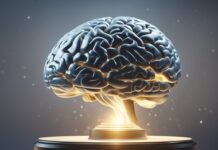
What was the first word you said the day before yesterday? Remembering it will take a lot of effort, yet the possibility of recalling it is 0.09%.
But if I ask you to recall the alphabet from A to Z, you will do it quickly. Right?
How is this possible? You can’t remember something from two days ago, but you still remember something that was taught to you 25 years ago.
Since birth, we are bombarded with lots of information, but do we remember all of it? Certainly, not. Then what happens to all the information we encounter in our life but don’t remember?
Have you ever wondered what happens to our forgotten memories or thoughts? Where do they go?
Note: If you'd like to learn more about thoughts and where they are coming from read this post.
The human brain is considered equivalent to computers. So when we delete files from the computer, it goes to the recycle bin. But what happens when we forget things? Let’s find out!
Know The Human Brain
The human brain is the most complex and fascinating structure of the human body. Even after much study and research, we understand only 10% of it. Our memories make us who we are in terms of being human, and they build our understanding of the world and predict our future.
We see and remember many different things, from people to nature, words we use to interact with others, etc. All this diverse information stored in our brain, which we use further to live our life, is collectively called memories.
For a very long period, scientists have been striving to interpret memories, how they are formed, where they are stored, etc. But that is only one aspect of it. To know where our thoughts go, first, we need to understand how we remember and how and why we forget.
How Are Memories Formed?

Memory refers to acquiring, storing, preserving, and retrieving information for later use.
Scientists have categorized memories into two types, which are – short-term memory and long-term memory. Short-term memory translates to the information we remember for a short period to finish an action—for example, one time password (OTP) for a website login.
Note: Short-term memories are processed in the prefrontal cortex region.
On the other hand, long-term memory translates to information we remember for days, weeks, months, and years. For example, the alphabet that was taught to us in our childhood days.
Note: Long-term memories are processed and stored in the hippocampus part of the brain.
How Does The Brain Remember Things?
Our brain is categorized into different areas, and each has a function. And it has been found that other areas of the brain are involved in the process of remembering things.
The hippocampus is considered the area of the brain that first stores the memory, and over time, this memory is stored in another part of the brain called the neocortex.
Now you might wonder how the transfer of information from one place to another occurs.
This information transfer occurs via the neurons’ co-activity across different brain parts via electrical impulses called action potentials. The same information is then propagated across all the neurons at a specific junction called synapses.
During memory formation, some synapses between neurons are stronger, while others are weakened. Thus, as connections between these neurons subside, accessing the information they contain at that particular time becomes difficult.
And thus, we forget.
This process applies to all memories and thoughts. When we think, our memory centers are engaged, and thus the synapses between neurons become more robust, but they may weaken with time.
We remember things by strengthening connections between neurons; forgetting happens when the connection gets weakened. So, thoughts and memories don’t go anywhere; they become difficult to access.
How Do We Forget Things?

Earlier, scientists suggested that forgetting is a passive process in which unused memories decay over time, like a photograph left in sunlight.
But after a little more advanced research, it came out that our brain is built to forget things. Forgetting is an active mechanism that constantly works in the brain. We store various kinds of information in different areas of our brains and process and remember information via neural activity through synapses in our brains.
Synaptic plasticity is the process by which neurons continuously produce new proteins, enabling them to strengthen their connections with one another selectively. This creates a network of cells that, together, encode a memory.
The more memory is recalled, the stronger its neural network becomes. With time, through consistent recall, that particular memory becomes stored in both the hippocampus and cortex.
There are two ways in which we forget things:
- Temporary: We forget a particular thought for a short period, and after a while, when someone reminds us about that, we begin to remember.
- Permanent: We forget a particular thought forever, regardless of whether we are reminded of that thing again. This happens during excessive alcohol consumption.
What Happens To That Forgotten Information?
According to science, we cannot destroy a thing or even a thought; it just changes its form from one to another. So, the information stored in our brain that we consider forgotten is stored in a form that is hard to perceive.
To remember that information, we apply learning tips and tricks.
For example, if we consider our brain as a tree and each branch of the tree as a thought, then is it possible to locate each branch?
No.
But that doesn’t mean that the branch is not present and does exist. However, we are not able to locate it.
Now suppose if we revisit that particular branch every day, our brain will mark that branch as important information, and thus it becomes a long-form memory.
Conclusion
The bottom line is that every information or piece of thought we encounter is present in our brain; however, some are retrievable easily, and some are not.
Our brain is built so that the process of forgetting happens on its own. We can’t control it. All we can do is constantly revisit the important information so our brain can store it in long-form memory.
You might get surprised by this but forgetting is necessary. It allows our brain to retain only the information important for survival and leaves space for learning and acquiring other equally important things in the future.




















